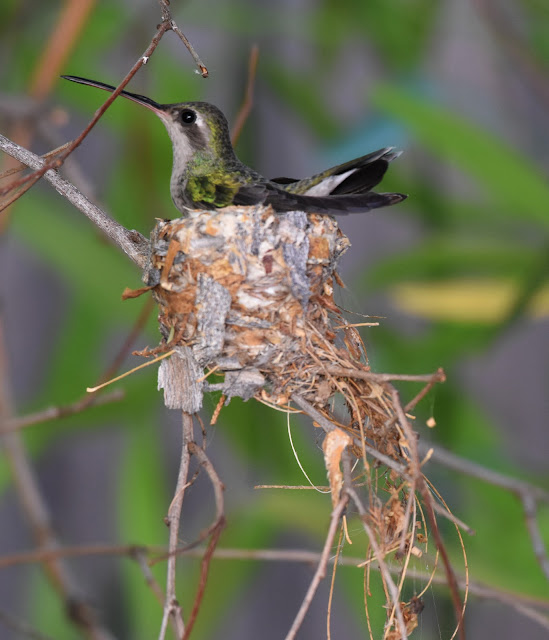The month of August is a busy one. I've returned back to work, continue to monitor key bird areas around Tucson and lead several trips. August is also known as an excellent month for shorebird research. And it's also challenging due to their hidden and remote locations.
Currently in my yard, I am monitoring a Broad-billed Hummingbird nest. On the 14th of this month, I found the nest with two eggs.
Now I have two baby hummingbirds growing up right before my very eyes. The mother decided to put this nest right next to my car. So now I have to be super careful getting out!
Okay. Currently, their bills are poking out of the nest and it's a bit of a poop fest. I know it's a full time job Mom but couldn't you clean up around the edges?:) To help Mom out, I filled up the feeders. She now begins to catch insects and drink nectar to make a slurry for the babies. Think of it as a bug protein shake. And there are plenty of mosquitoes in my garden right now.....so have at it:)
August also brings with it bugs and heat. However, shorebird migration is rather exciting. Encouraged by a report from friends, I went with Micheal and Magill to find a rare Ruddy Turnstone. It was nasty work. I have a strong stomach but on this day, I almost lost it.
 |
| White-faced Ibis |
I laughed because Micheal had just gotten out of work and there he was in his bright pink scrubs in the middle of Mad Max land. However, I needed company. I can't drive these longer distances anymore without falling asleep at the wheel. It's hot and it's boooooring!
 |
| An excellent state bird for Arizona, the Ruddy Turnstone |
A couple weeks later, I get a text from Magill about a Red Knot. This is ANOTHER state bird that can be tricky to spot. It's also a very rare migrant. But the catch? It was found at yet another sewage treatment facility up in the Phoenix area.
 |
| Stilt Sandpiper |
 |
| A fantastic state bird for Arizona, the Red Knot |
While work has taken up a good chunk of that precious time, I have found a little break time to monitor our nesting Purple Martins at my job site. They are gone now. But each year I get a couple weeks with them before their large group migrates away.
I'd like to also stress the importance of vegetation. If that saguaro wasn't there, there would be no Purple Martin activity ever. Sadly, this saguaro has seen the pristine desert around it disappear over the last 16 years. Today, a huge solar panel stands next to the last of its remaining brethren. They are also now surrounded by a developing housing project. Yes, I worry about this saguaro and I will be sad if anything ever happens to the 4 that still remain. But this one saguaro has been home to 5 different nesting bird species AND provides food during our hot spring month of May for our desert birds!
 |
| a male Purple Martin flies about their Saguaro |
I just came back from Mexico and will be writing that blog post in a few days. I'm taking the weekend off to catch up with all of you and have a nice cup of coffee in my pajamas.
So for now, I hope you avoid(or not), nasty piles of ground up dead cattle. If you are in Arizona, this is where you'll find the rare treasure birds right now. These excellent birds are found around these poop filled watering holes. While it's not as scenic as say the Grand Canyon, it's where state chasing birders go this month. Until next time.....














The hummingbird nest is just cuteness itself :) Well done on the new "ticks" although birding near sewage works and dead cattle etc. not my idea of fun!! Have a wonderful weekend :)
ReplyDeleteFirst of all...WOW! We had a hummingbird nest on our back porch in the ivy when we lived in Tucson the first time back around 1980. My few photos were horrible! How I wish I could have taken such amazing photos! I loved seeing yours. Just....WOW! And the state birds you saw this month were awesome. How awful about the dead cows...now, YUK! I really hope that saguaro stays put...those sweet birds need that nesting spot! Have a great week, Chris. And btw I am having trouble identifying the hummers I am having visit our feeders. I'm pretty sure we have a male and female rufous, maybe two males, and there is a really tiny almost solid green-backed one that I can't figure out. A female Anna's too maybe. I even thought maybe a broad-billed. As I post my photos of hummers, please try to let me know what I have! Thanks!
ReplyDelete